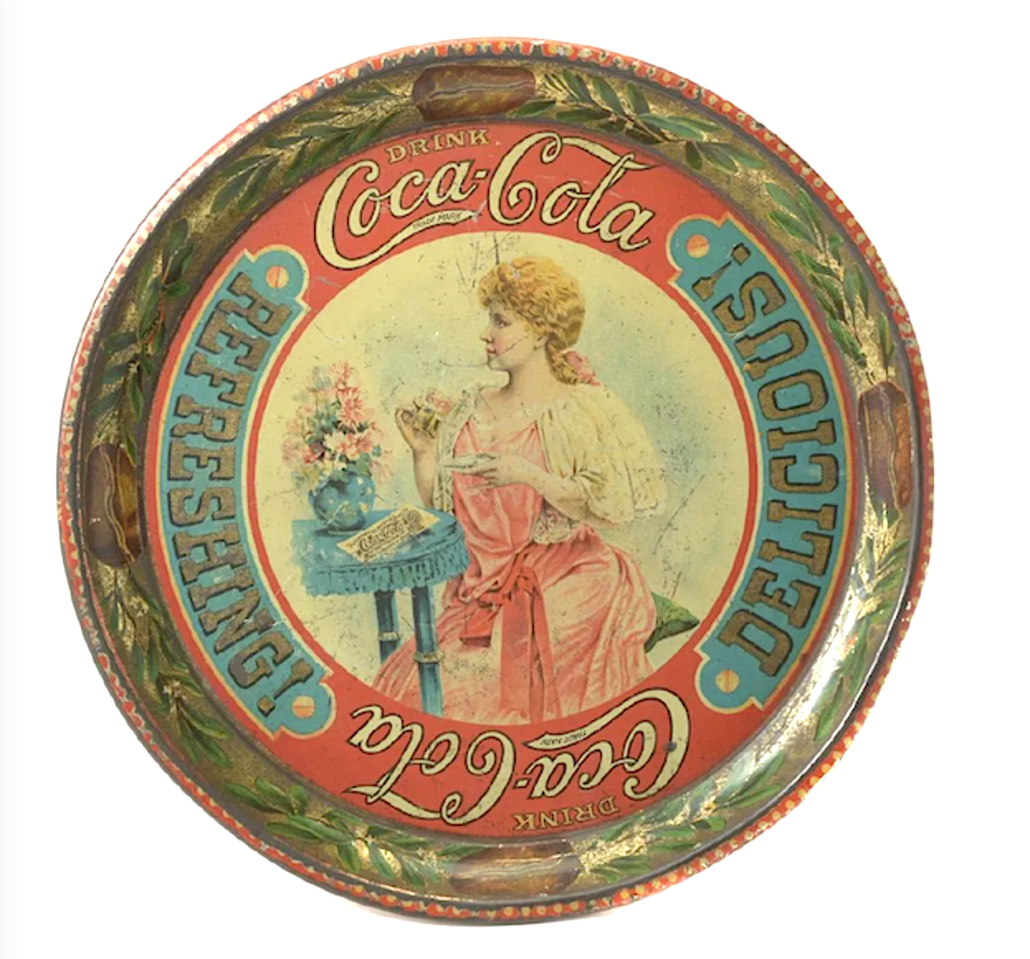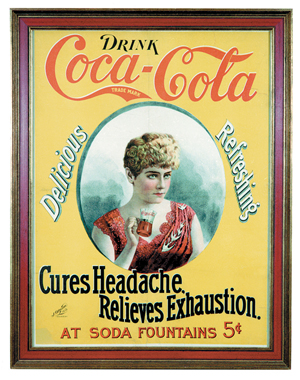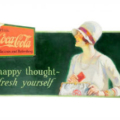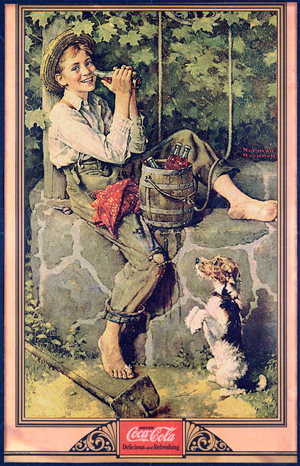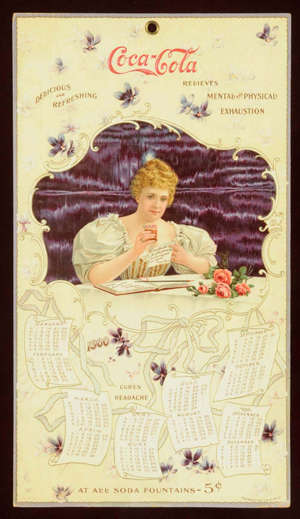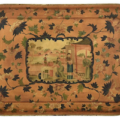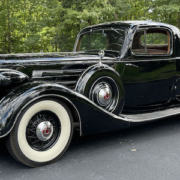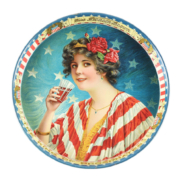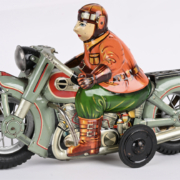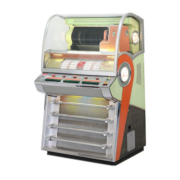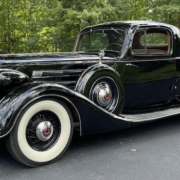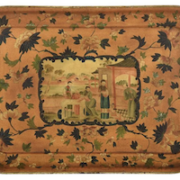Pictorial trays helped Coca-Cola build a powerful soda brand
An original 1897 Coca-Cola tray with painted cola leaves and nuts decorating its rim, achieved $50,000 plus the buyer’s premium in February 2019. Image courtesy of Michaan’s and LiveAuctioneers
NEW YORK – Far and away, Coca-Cola is the world’s bestselling soft drink. The company claims that nearly two billion eight-ounce servings are consumed every day. So, exactly how does a sugary soda dominate all others for more than 100 years? The answer is marketing and then more marketing. Coca-Cola trays were key to building the beverage’s brand.
Coca-Cola was not intended to become the drink that conquered the planet. Its original formula was created as a health supplement by pharmacist and wounded Confederate soldier John Pemberton at his pharmacy in Columbus, Georgia in 1885. His war injuries led to a morphine addiction, which prompted him to seek a tonic that would help him kick that habit. It was available exclusively at soda fountains in pharmacies as a proudly nonalcoholic drink for five cents a glass. Sales were fine with simple newspaper ads, but not brisk.
Pemberton’s formula relied on coca leaves mostly sourced from Peru (as it does today) with a small amount of cocaine – about 3.5 grams – yielded as a natural byproduct of gathering the fluid extract from the leaves. This was mixed with cola nut extract (sometimes spelled “kola”), which delivered the stimulant caffeine, and also mixed with sugar and carbonated water to create the finished drink. Neither cocaine nor its aftereffects were well understood at the time, but it was a surprisingly and distressingly common ingredient in patent medicines, promising to alleviate whatever ailed you. The cocaine extract was removed from the Coca-Cola manufacturing process as early as 1903 (although some reports suggest it may have disappeared as late as the 1920s) once its addictive properties were better understood and regulated. The caffeine, a far more acceptable pick-me-up, was retained, however.
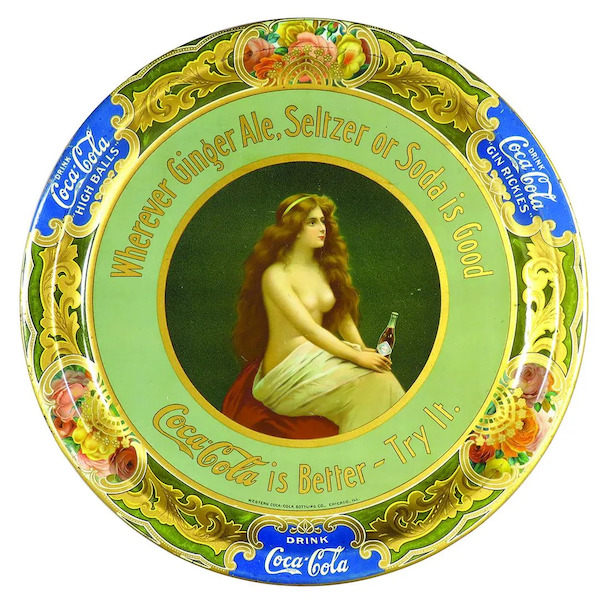
A 1908 tray featuring a topless Coca-Cola girl sold for $9,000 plus the buyer’s premium in September 2020. Image courtesy of Showtime Auction Services and LiveAuctioneers
Asa Candler bought the formula from John Pemberton in 1888 for a bit more than $238 (other reports cite a higher sum) and eventually founded the Coca-Cola Company in 1892. A master salesman, Candler began providing soda fountains and bottlers with the company’s most enduring giveaway product: the Coca-Cola serving tray. Its popularity with collectors have prompted reproductions of the earlier tray designs to flood the market. So how can you tell if you have an original or a reproduction Coca-Cola tray?
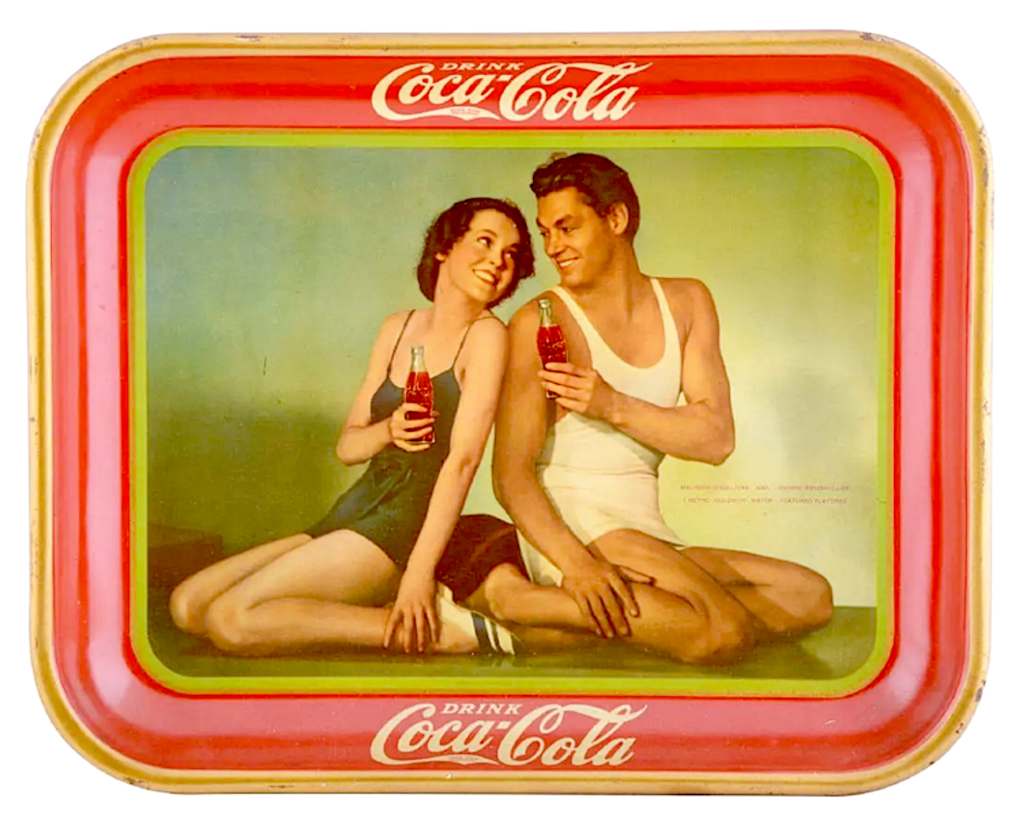
A near-mint 1934 Coca-Cola tray picturing actors Maureen O’Sullivan and Johnny Weissmuller savoring the soda realized $1,100 plus the buyer’s premium in December 2018. Image courtesy of Dan Morphy Auctions and LiveAuctioneers
Graphics
Collectors can follow the fashions of the times through the depiction of the Coca-Cola girl on the serving and tip trays illustrated by famous artists such as Haddon Sundblom, whose take on Santa Claus would codify the jolly old elf’s appearance now and forever. Victorian ladies with high hats and parasols were featured on Coca-Cola trays in the late 19th and early 20th century. The Flapper emerged in the 1920s, and each subsequent decade reflected current trends. Celebrities such as opera star Lillian Russell, actress Maureen O’Sullivan and Tarzan star Johnny Weissmuller were all featured on Coca-Cola trays. The graphics were impeccably crisp and clear, while the reproductions after 1970 were less so. But even if they show signs of aging and cosmetic damage, earlier trays can command strong prices at auction, depending on their graphics and the overall design.
Classic and Modern Trays
The Coca-Cola Company produced its first tray in 1897, and ultimately became known for four types of trays: a round serving tray; an oval serving tray, a rectangular serving tray that was introduced in 1910; and a corresponding smaller tip tray. Coca-Cola trays manufactured between 1897 and 1968 belong to the classic period and are the most coveted at auction. Those manufactured after 1970 are considered modern trays. They are reproductions of trays of the classic era and are made with later materials such as hard plastic or thinner-gauge metal and are usually ignored at auction.
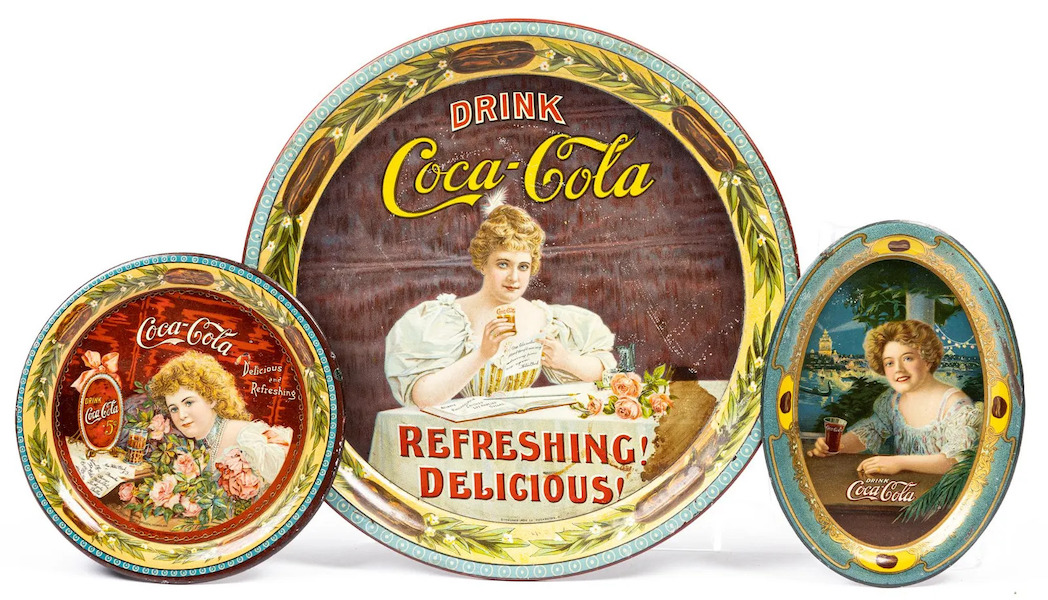
A lot of classic-era Coca-Cola trays containing one round tray, one oval tip tray and one round tip tray, offered with an estimate of $600-$1,500, ultimately sold for $3,200 plus the buyer’s premium in May 2021. Image courtesy of Ida and Larry Goldberg Coins & Collectibles and LiveAuctioneers
Companies Producing Trays
The Atlanta-based company enlisted several different firms to make its branded trays. The first was the Tuscarora Advertising Company in Coshocton, Ohio. The Standard Advertising Company, also from Coshocton, followed. By 1900, those two companies merged to form the Meek and Beach Company but soon parted ways, continuing as the H.D. Beach Co. and the Meek Company. In 1909, the Meek Company became American Art Works. These changes matter to Coca-Cola tray collectors, as they help identify each tray based on the trademark and company name. Other companies that also produced trays included Charles W. Shonk Company, the New York Metal Ceiling Company, Tindeco and Stelad Signs.
Quality
The serving trays and the tip tray were made via the lithography process using high-gauge metal that gave the trays some heft. Every separate color – a classic-era Coca-Cola tray might employ eight to 10 – required a separate pass over a polished piece of limestone block featuring a specific design created by ink pencil. The images were high quality with crisp, clean, lustrous color throughout and fine detail, which helped propel these early trays to immediate success. Reproduction trays, on the other hand, were saddled with muddy graphics and usually lacked key components of the original design. Collectors keep them only as place holders or to trade for the better ones.
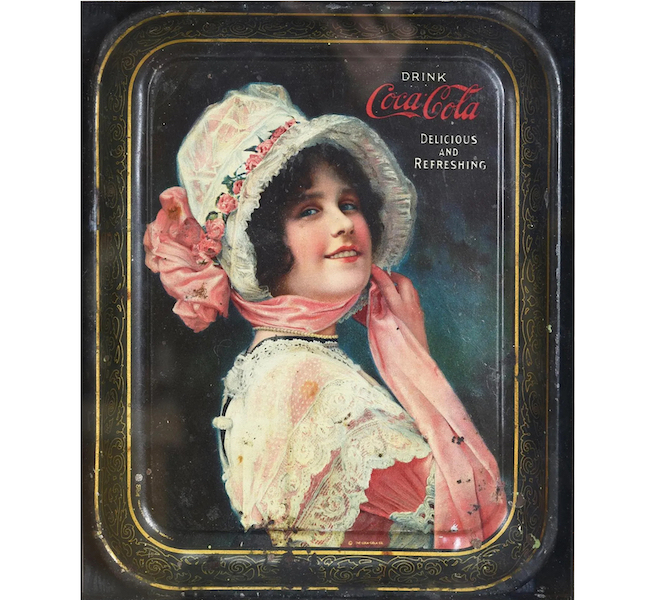
Rectangular Coca-Cola serving trays became standard in 1910. This example, produced in 1914 and showcasing the Coca-Cola girl and the slogan ‘Delicious and Refreshing,’ brought $125 plus the buyer’s premium in April 2021. Courtesy Route 32 Auctions and LiveAuctioneers
Size and Color
Size and color matters for classic-era trays. While the front of the tray featured the colorful graphics, most trays had brown color schemes with green and brown borders. In contrast, trays of the 1920s featured the red color scheme we are all familiar with today. The reverse of a classic-era tray shows the undecorated pot metal to be a gun metal gray, black or a dark tan color. Reproduction pieces will show green or very light tan. The smaller tip tray will measure 4.5 by 6.5in, while the round tray will have a diameter of nine or 10in across and the standard rectangle tray will be 13 ¼in wide by 10 ½in tall. Reproductions tend to fudge these official dimensions.
Copyright and Trademarks
Classic-era trays sport the Coca-Cola trademark inside the flowing tail of the ‘C’ in ‘Coca’ and should say ‘Trade Mark Reg. US Pat Off.’ By 1940, however, the trademark tagline was positioned under the Coca-Cola corporate name. Reproductions do not show this trademark, and usually declare themselves as reproductions in language placed along the bottom rim. The bottom left of the tray states the manufacturer and the year it was produced; on the bottom right, the artist of the graphic will sometimes be credited.
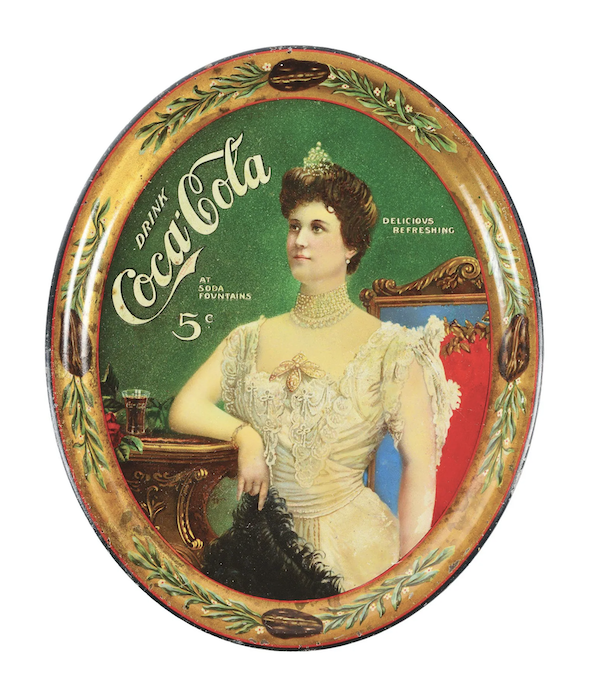
A 1905 Coca-Cola tray showcasing the Coca-Cola girl and surviving in excellent condition earned $1,700 plus the buyer’s premium in August 2022. Image courtesy of Dan Morphy Auctions and LiveAuctioneers
These six components are the basic identifiers that determine if your antique Coca-Cola tray is ‘The Real Thing.’ With nearly 80 years of variations and graphics, collectors can narrow their focus to sizes, colors, graphic, model, slogans or any combination of these to amass a collection of pure Americana. Many Coca-Cola collector clubs exist that stand ready to provide details and history of the initial decades of a company that is almost 140 years old.
Collecting Coca-Cola trays doesn’t just celebrate a beloved soft drink; it charts the somewhat improbable climb of a patent medicine-era beverage to the status of a global icon. It’s an achievement worth toasting – with Coca-Cola served on a vintage Coca-Cola tray, of course.


